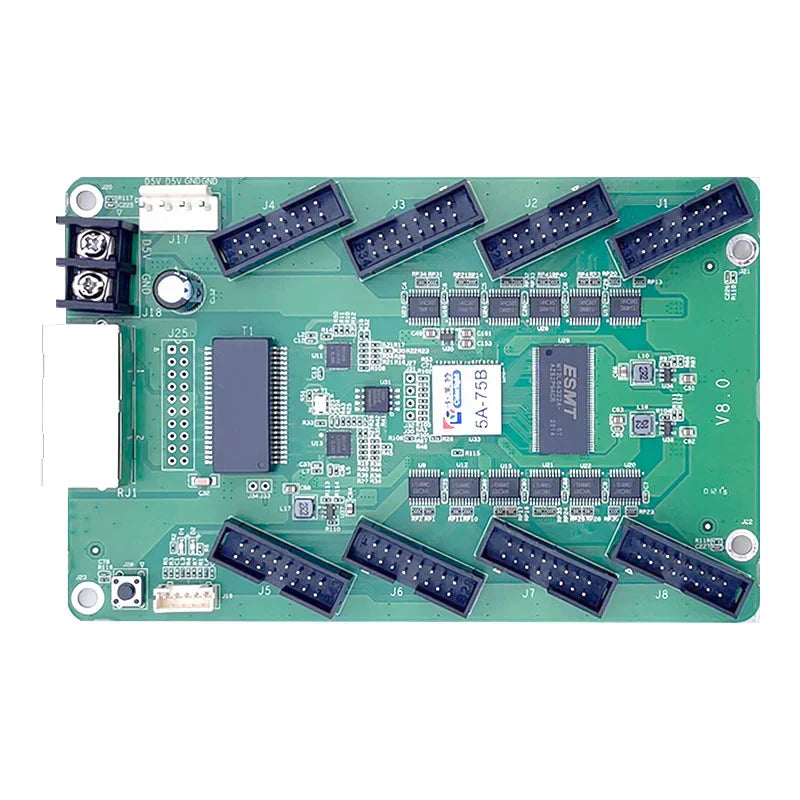In the LED display industry, most focus goes toward pixel pitch, brightness, cabinet structure, and power solutions. However, a deeply influential component is often overlooked—the LED Receiving Card. Though small and unseen by viewers, it serves as the true “image processing brain” of the entire display system.
Whether it’s for commercial digital signage, stadium scoreboards, live events, church worship screens, corporate presentation walls, or iconic 3D city billboards—image quality stability depends heavily on the receiving card.
📌 When equipment is chosen right
The audience will see the difference instantly
✅ What Is an LED Receiving Card? More Complex Than It Looks
Every receiving card must perform real-time pixel-level operations within milliseconds:
✅ Decode incoming data from the sending system
✅ Apply brightness, gray scale, and color correction algorithms
✅ Distribute data precisely to thousands of LEDs
✅ Monitor system voltage, current, and status
In simple terms, every millisecond it must:
🔻 Receive
🔻 Analyze
🔻 Process
🔻 Command every pixel to light up
And it must do all this without errors or delay.
📌 The receiving card determines the upper limit of visual performance
✅ Why It’s the Hidden Key to Better Image Quality
LED displays require highly synchronized and accurate data processing. A high-performance receiving card directly improves:
⭐ High Refresh Rate: Eliminates Flicker and Scan Lines
-
Essential for broadcast, camera capture, and live events
-
≥1920Hz is the professional baseline
⭐ High Gray Scale: More Accurate Visual Depth
-
Smoother transitions in dark areas
-
More natural skin tones and details
Poor gray scale results in:
❌ Color banding
❌ Dim night scenes
❌ Unrealistic tone gradients
⭐ Pixel-Level Calibration: Uniformity Across Panels
-
Eliminates module-to-module color differences
-
Critical for fine-pitch LED displays (P1.x and below)
⭐ Larger Load Capacity: Cost Optimization
-
Larger area handled by fewer cards
-
Reduced wiring and lower failure risk
⭐ Redundancy: Zero Blackouts in Mission-Critical Projects
Black screens in:
-
Live shows
-
Government events
-
Monitoring centers
→ Consequences are severe
Redundancy protects the entire signal chain
⭐ Control System Compatibility: Key to Stability
Consistency across the brand chain ensures:
✔ Easier debugging
✔ Higher reliability
✔ Better long-term maintenance
✅ Different Applications Require Different Priorities
Each project category has its own demands:
| Application | Priority Factors |
|---|---|
| Church & Meeting Space | Low brightness / high gray scale performance |
| Live Stage & Concert | High refresh rate / low latency |
| Outdoor Advertising | Anti-interference, high loading |
| Retail Signage & Wayfinding | Cost-effective reliability |
Consider first:
📍 Environment / Screen Size / Visual Requirement / Control System Brand
✅ Upgrading the Receiving Card: Best Path to Revitalize Existing Screens
Already have an LED screen but noticing:
-
Flickering in camera recordings?
-
Motion blur?
-
Poor detail in dark images?
-
Random black blocks or tearing?
In most cases:
❌ It’s not the LED modules
✅ It’s the receiving card limiting performance
📌 Low-cost upgrade
📌 Immediately visible improvement
Ideal for:
✅ Church display upgrades
✅ Conference screens modernization
✅ Advertising screen quality enhancement
✅ Recommended LED Receiving Card Models
| Model | Load Capacity | Product Positioning |
|---|---|---|
| MRV208-1 | 256×256 | Standard HUB75 model |
| MRV412-1 | 512×384 | Enhanced capacity |
| MRV416-1 | 512×384 | Strong indoor performance |
| MRV570-1 | 512×256 | Self-monitoring for higher stability |
| A5s Plus | 512×384 | HDR-optimized, ideal for fine-pitch |
| A8s-N | 512×384 | High-load, wide compatibility |
| A10s Plus-N | 512×512 | High-end engineering flagship |
| A708 | 512×256 | Practical entry standard |
| A712 | 512×384 | Retail & business mainstream |
| A716 | 512×384 | Excellent value/performance |
| I5 | 320×256 | For smaller screens |
| HD-R716 | 320×256 | Stable HUB75 engineering choice |
| HD-R712 | 320×256 | Reliable all-around model |
| HD-R708 | 256×256 | Best budget option |
| 5A-75E | 256×1024 | Large vertical load capability |
| 5A-75B | 256×1024 | Widely used and highly stable |
✨Conclusion: Unseen Control Defines Visible Quality
The audience may never see the control system inside the screen.
But they will see the results it produces.
True professionalism comes from:
✔ Stable signal processing
✔ Fine visual performance
✔ Long-term reliable operation
💡 The more hidden the component,
the more it influences everything.
Whether you are planning a new LED display
or upgrading an existing installation —
choosing the right LED receiving card
means choosing better presentation,
better visual experience,
and better results ✅

